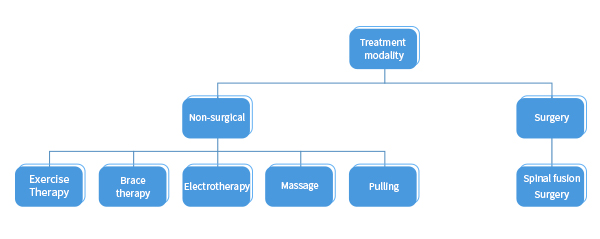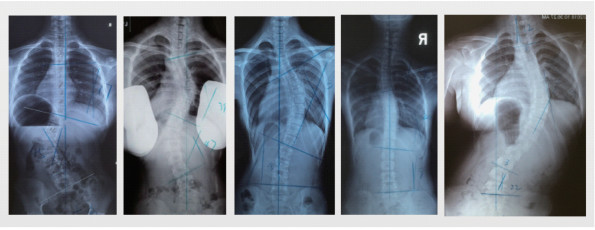In recent years, 3D printing, as a digital technology, has the advantages of precision, customization, flexibility and speed, which is very much in line with the advanced concept of "precision medicine" and "digital medicine", and is widely used in the medical field. Especially in the application of orthopedic and rehabilitation aids, personalized and customized 3D printed scoliosis orthoses have started to be used by more and more patients.
What is scoliosis
Scoliosis is a disease that seriously affects the normal development of the patient's body and usually continues to worsen as the patient grows and develops, and the faster the growth rate, the faster the worsening rate. In severe cases, it leads to deformation of the thorax, affecting heart and lung function, and even involving the spinal cord, resulting in paralysis. Scoliosis is defined by the Scoliosis Research Society (SRS) as follows: scoliosis occurs when the spine deviates laterally from the midline in the frontal plane, the Cobb angle exceeds 10°, and the vertebrae rotate in the horizontal plane. That is, scoliosis causes deformation of the spine in the frontal, horizontal, and sagittal planes, and is accompanied by a series of abnormal deformations of the spine in three-dimensional space, such as vertebral rotation, spinal torsion, and reduction in the curvature of the physiological curve.
For the treatment of scoliosis, the internationally accepted treatment methods are surgery and conservative treatment. Surgery is highly invasive, risky and expensive, and most adolescents do not meet the indications for surgery and are reluctant to use it. Therefore, conservative treatment becomes the first choice for patients. Conservative treatment includes scoliosis orthoses and other supplementary sports exercises, but until growth and development are completed, scoliosis orthoses are relied upon to apply continuous corrective force to the spine to achieve correction.
How to treat scoliosis

First, according to the degree of deformity of the patient's spine, age, degree of trunk balance and other factors to determine the need for surgical treatment; for scoliosis angle is not large, generally within 20 ° idiopathic scoliosis, can be suspended without treatment, close observation; if the scoliosis angle is greater than 20 ° less than 40 ° or due to the review of X-ray scoliosis angle increased by more than 5 ° per year, conservative treatment is required; if the patient is an adolescent, should Non-surgical treatment should be chosen whenever possible; surgical treatment is usually the final modality after no other modalities have had a significant effect. Bracing is currently the most common conservative treatment for scoliosis.
The production process of scoliosis orthosis
(1)Traditional production process
Traditional orthoses are generally made by taking plaster, trimming, attaching thermoplastic plates, cutting, sanding, and installing liner ties. The advantages are that it is relatively inexpensive and can be heated and trimmed twice. The disadvantages are that the whole process is relatively cumbersome, the plaster taking requires patient participation, which reduces the patient's experience, the production efficiency is low, one orthotist can make at most 3-5 patients' braces a day, in addition, the traditional orthotics are large and difficult to hide, which has a relatively large impact on the normal study and life of adolescents.
(2)Digital Medical 3D Printing Custom Orthotics
With the development of digital medicine, 3d printing technology began to be popular in the field of medical customization. Among them, 3D printing personalized scoliosis orthosis, is on the theory of traditional orthosis, combined with digital design and 3D printing technology, the development and production of scoliosis orthosis, which through CT scan or 3D scan combined with X-rays as the basis for design, through digital software (based on the principle of traditional orthosis 3-point pre-bending and combined with the patient's body type, breathable, individual, lightweight concept design model ) to obtain printable three-dimensional data, and then use materials that meet medical requirements and 3D printers to produce personalized scoliosis orthoses for different bodies.

Advantages of 3D printed custom scoliosis orthoses
1、Customized design, combined with the actual human body data of each patient for the exact parameters of the design, a good fit, patient comfort to wear.
2、Ergonomically made, for different patients' living habits, the design of the linkage, locking place, etc., patients can wear themselves, greatly improving the wearer's compliance and comfort.
3、Beautiful modeling and lightweight design, due to the use of high-standard special materials, the design is thin and can be easily hidden in the outer clothing, reducing the patient's psychological pressure and meeting the external image requirements.
4、With a certain toughness, permeability, good ventilation is not easy to damage, can be worn at any time does not affect the daily study, life, to enhance the effective wearing treatment time every day, better and faster to achieve the therapeutic effect.
5、Good treatment economy, patient visits, treatment pressure is low, although China's related applications started late, but due to the in-depth use of 3D printing technology, making a comprehensive treatment cost compared to the traditional process has a significant advantage.
6、The project as a whole is more mature, due to the vigorous promotion of Shanghai Jiuyuan in recent years, has basically formed a complete process system of doctor-guided diagnosis, engineer design and manufacturing, orthopedist evaluation and tracking, with the ability to promote a wide range.
3D printed spinal orthosis demonstration
Among the many types of rehabilitation aids, orthotic manufacturing is currently the most closely integrated with additive manufacturing - 3D printing technology applications and is still being optimized and developed. In the process of application development, 3D printing technology and 3D scanning, digital design software and orthopedic manufacturing needs are integrated, gradually forming a complete digital design and 3D printing process, which brings a new blueprint for orthopedic and other rehabilitation aids. We have a complete set of data analysis and 3D printing personalized solutions (Amira software & Essentium printer) for medical rehabilitation assistive devices, please feel free to call us for more information.





























 Home
Home Telephone
Telephone Message
Message







